Archive for the ‘Field trips’ Category
October 13, 2018
All three first year Marine Science classes made it out to Race Rocks on Wednesday 10 October. We saw many, many, many California and Northern sea lions.
And most students were also fortunate enough to see humpback whales feeding off the south and west sides of Great Race Rock. (Terrible photos of humpbacks below followed by a decent photo of whale watching students!)
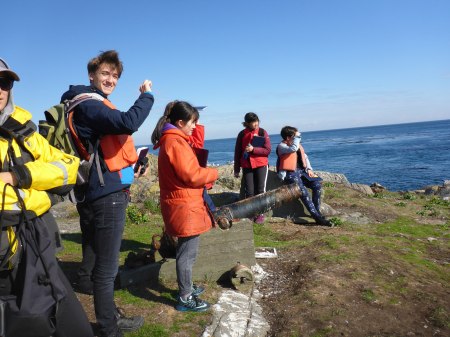
The newly minted Coastal Biodiversity CAS also had the opportunity to visit Race Rocks with Garry Fletcher on Friday afternoon.
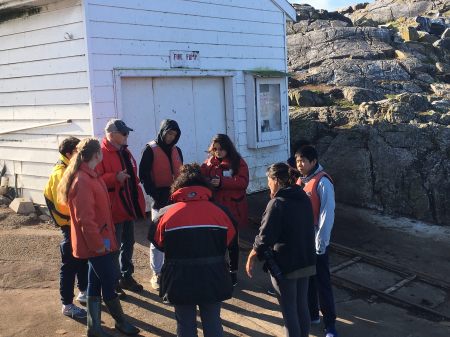
During that visit we saw a necklaced sea lion and we came across a dead Northern sea lion.
We also had a reunion of two Year 38 students, Laas, the current Ecoguardian at Race Rocks, and Helen, who is back at Pearson College for a two week visit. Incidentally these were the two artists who painted my VW van!!

Wonderfully impressive experience overall!!
Tags:california sea lion, Humpback whale, Northern sea lion, Race Rocks, year 38, year 44, year 45, Zalophus californianus
Posted in Field trips, Marine organisms, Where are they now? | Leave a Comment »
September 24, 2018
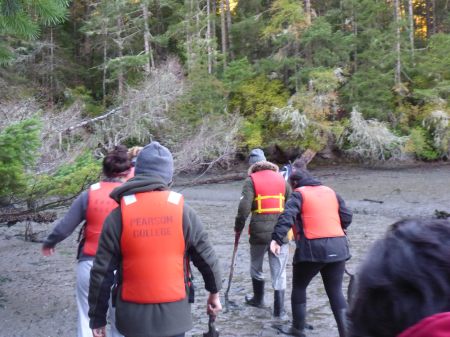
Heading into the mudflats
Today was one of the days that I look forward to every year – Mudflat Monday! Two of the three classes braved the challenging ecosystem that is the mudflats today (the third class went last Thursday, so actually they were the first class!).
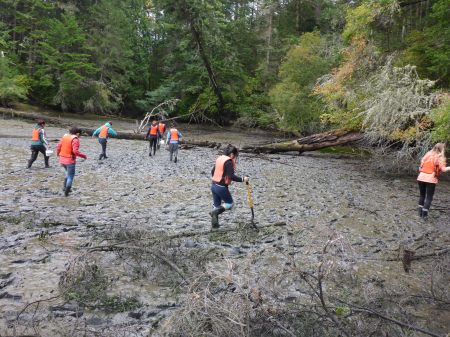
Slogging through the mudflats
We found clams, worms and crabs…

Laura’s impression of a bent-nose clam, Macoma nasuta

Lugworm, Abarenicola pacifica

Inaki and a graceful rock crab, Metacarcinus gracilis
We really got our gumboots and hands dirty today! This truly is science you can sink your boots into!
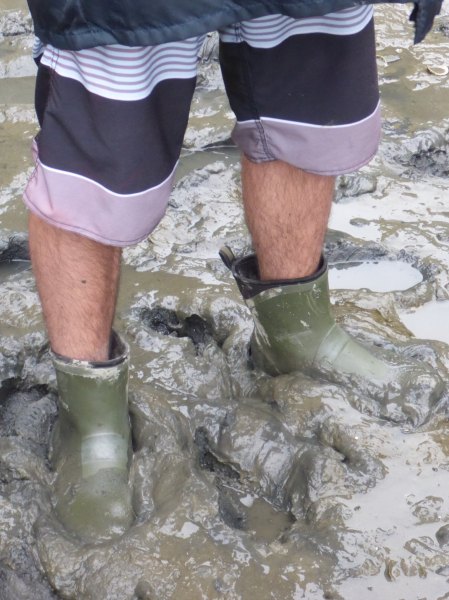
Juan Daniel’s boots

Lara’s interpretive dance?
Tags:Abarenicola pacifica, Bent-nose clam, Graceful rock crab, lugworm, Macoma nasuta, Metacarcinus gracilis, mudflats
Posted in Field trips, Fun Activities, Marine organisms | 1 Comment »
May 3, 2017

Abigail and Annie measuring dimensions

Erik measuring temperature and salinity

Matias and Erik measuring

Matilda and Millie observing

Matilda
D block marine scientists were very fortunate to get to Swordfish Island yesterday to do a tidepool study. In addition to measuring the dimensions of two tidepools, they compared temperature, salinity and dissolved oxygen of high and low tidepools. Students also made species lists for both of the tidepools they were examining.
We did expand our exploration beyond tidepools because this is such a stunning place. Here are a few of the spectacular marine species:

New bull kelp in intertidal zone

Giant green anemone with barnacle molts

Striped sun star with commensal worm

Leather chitons and channeled dogwinkle with egg capsules

Six armed sea star
And two terrestrial species:

Camas

Succulents
So beautiful!
Tags:Anthopleura xanthogrammica, Camas, egg capsules, Katharina tunicata, Leptasterias hexactis, Nereocystis luetkeana, Nucella canaliculata, rocky intertidal zone, Solaster stimpsoni, Swordfish Island, tidepools
Posted in Field trips, Marine organisms | Leave a Comment »
May 2, 2017
Every year I issue a challenge to marine scientists to compare the biodiversity of two habitats. I suggest high & low in the intertidal, horizontal & vertical in the rocky intertidal, plankton tows in two locations or two areas on the dock. I always offer the option of snorkelling and a few students, like 3 or 4, usually take me up on it.
This year there were more takers for the snorkelling option than ever – 7 students in the first class and 6 in the second class.

Ivonne and Yorlenis

Becca and Matilda

Annie and Abigail

Becca and Matilda

Abigail

Emilio
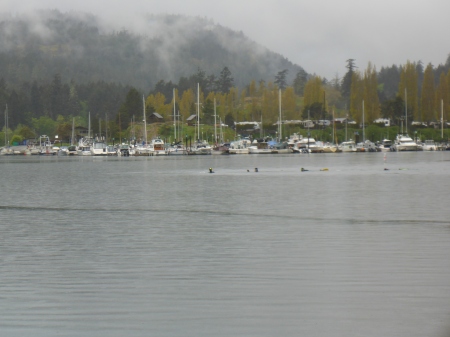
A few students even snorkelled across Pedder Bay to compare the two different sides of the bay (see photo above).

D block snorkellers

Gaia emerging
And not all students snorkelled, below are Tomma in the intertidal and Karel sampling plankton at the green buoy. While Karel and I were in Hyaku, we watched a submarine make its way to the navy dock.

Tomma sampling intertidal biodiversity

Karel sampling plankton diversity

Submarine!
For more photos see Flickr album Biodiversity 2017.
And for a reminder of last year’s sampling see Biodiversity in Pedder Bay.
Tags:biodiversity, Pearson College dock, Pedder Bay, snorkeling, submarine
Posted in Field trips, Fun Activities, Student research | Leave a Comment »
January 11, 2017
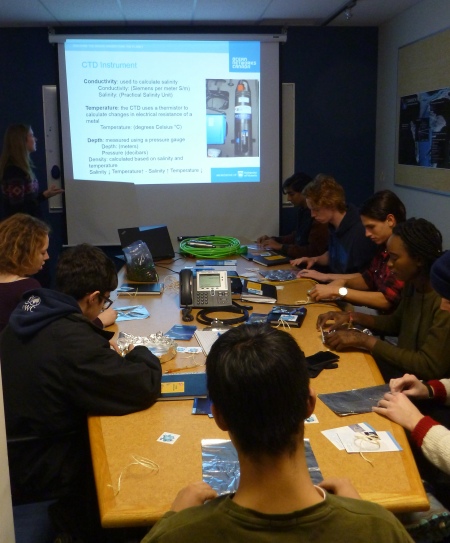
Pearson College (PC) students have had the opportunity to connect with Ocean Networks Canada (ONC) in a few ways lately. During block week (12-15 December 2016), second year Marine Science students travelled to the headquarters of ONC at the University of Victoria. Thanks to Natasha, Jessica and Mercedes for all that you taught us. In the photo above, PC students are using aluminum foil to create boats in a competition to hold the most ‘fish’ (actually marbles, metal washers and foam bits) in water of different densities.

Navoneel’s boat

Andras’ boat

Maya and Adi test their boats

Martin testing his boat

Special guest Suman floating his boat
Yesterday, 10 January 2017, Dwight Owens from ONC (and father of PC 41 Tessa Owens!) came to PC to present ‘Hot, Sour and Breathless: Oceans under stress’ to first year marine scientists. It was a wonderful review and preview – thank you Dwight!
And one final connection with ONC that I must mention, Dave Riddell spent almost two hours with me on 23 November 2016 guiding me through Oceans 2.0 which allowed me to assign a data analysis task to first year students. Thank you Dave!!
We are very lucky to be so close to such an incredible organization staffed by wonderful educators and scientists and doing leading edge marine science.
Tags:Ocean Networks Canada, properties of seawater, seawater
Posted in Events, Field trips | Leave a Comment »
September 29, 2016
This morning my plan for second year marine scientists was to go to Race Rocks to look at marine mammals (sea lions & seals) and birds. My plan went out the window, however, when Kyle spotted orcas as we were underway. We were totally distracted by these magical creatures. We didn’t made it to Race Rocks but we had a wonderful and transformative adventure.

Aurora, Orca, Andras

Orca in the distance

Aurora, Eskil, Andras

Axl, Martin, Aurora

Stefan, Jill, Navo, Zoli
We saw two females with a calf and two bulls. Although I don’t have any good photos of the whales, I did get many photos of the backs of students’ heads!
Tags:orca, Orcinus orca, year 42
Posted in Field trips, Fun Activities, Marine organisms | 1 Comment »
September 28, 2016
First year marine scientists had a wonderful experience at Race Rocks on Friday 23 September. We went to explore this amazing ecosystem and to observe marine mammals and birds.

We brought Felix Butschek (yr 36, Austria) along:
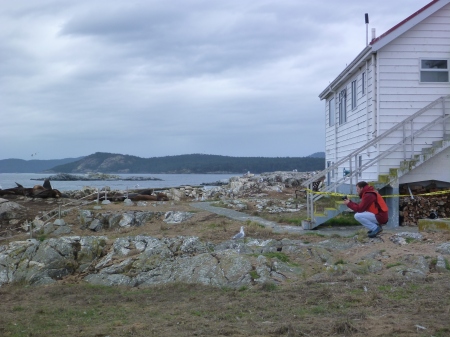
More details to follow on his visit later…
We did see (and hear and smell!) many, many sea lions:

Observing a California sea lion

Damage done to sea lion by a cookie cutter shark
We were also lucky to observe five Northern elephant seals:

Northern elephant seal

Elephant seal parade

Elephant seals and the jetty
As an added bonus one group of students also saw orcas:

Spyhopping orca

Orca in the distance

Whale watching

Orcas followed us to the mouth of Pedder Bay
For more photos see Flickr album here. And for Anne’s summary of the day and some better orca photos, see the Race Rocks blog.
Tags:california sea lion, Northern elephant seal, orca, Orcinus orca, Race Rocks, Stellar sea lion, year 36, year 43
Posted in Field trips, Fun Activities, Marine organisms | Leave a Comment »
September 19, 2016
On Wednesday and Thursday mornings last week, second year Marine Science students travelled across Pedder Bay to explore a nearby mudflat.
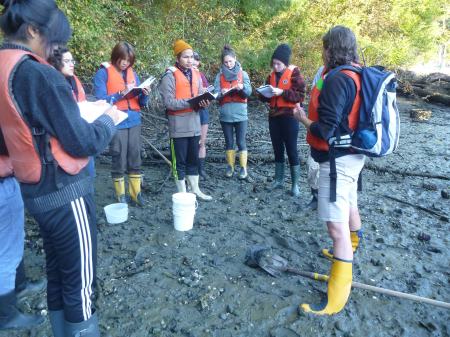
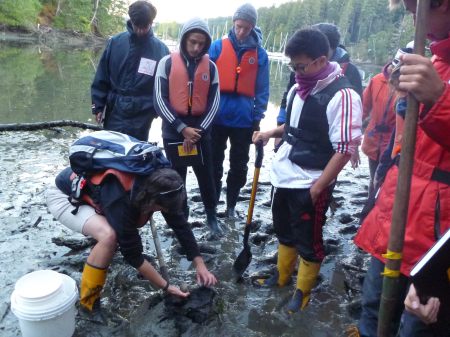
While it is a challenging ecosystem to navigate around, marine scientists did very well – not a single student was left behind, nor a single gumboot!

Racing across the mudflat

Getting some water for animals

Extracting a gumboot

Extracting Camila & her gumboots
Students learned that mudflats smell like rotten eggs due to hydrogen sulfide produced by anaerobic bacteria in the mud.

Sadly, there is not a lot of oxygen in the mud…

…but happily, there are several organisms that are well adapted to low oxygen and high hydrogen sulfide.

Axel digging in the mud

Kate and Maya digging deep to find a clam

Predatory ribbon worm ( Paranemertes peregrina)

Mara and Somchit
On Thursday we were fortunate enough to use the yellow voyageur canoe to travel across the bay.

Loaded up and ready to go

Heading home
The mudflat field trip is always one of the messiest in Marine Science, but also one that is great fun! (Right, Stefan?!)

Stefan making his way across the mudflat

Navoneel after his excursion to the mudflats
See Flickr album for more photos of the mudflats.
Tags:mudflats, Paranemertes peregrina, Pedder Bay, year 42
Posted in Field trips, Fun Activities | Leave a Comment »
May 10, 2016
On Monday 9 May, 26 Marine Science students travelled to Race Rocks on Hyaku or the Discovery Shuttle (chartered from Ocean River Sports since ‘Second Nature’ is still in the shop) to write their first year field exam.

Do they look like they are off to write an exam?

Discovery shuttle to Race Rocks

Aurora and Adi on Hyaku
Upon arriving at Race Rocks, students received their exam papers and instructions to travel to six stations around the island of Great Race Rock.

Second group of students arrives

Laura gives instructions for station 3

Getting to work at station 3
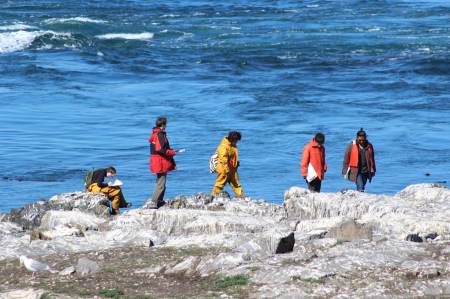
Only two significant challenges on this morning:
- The flies
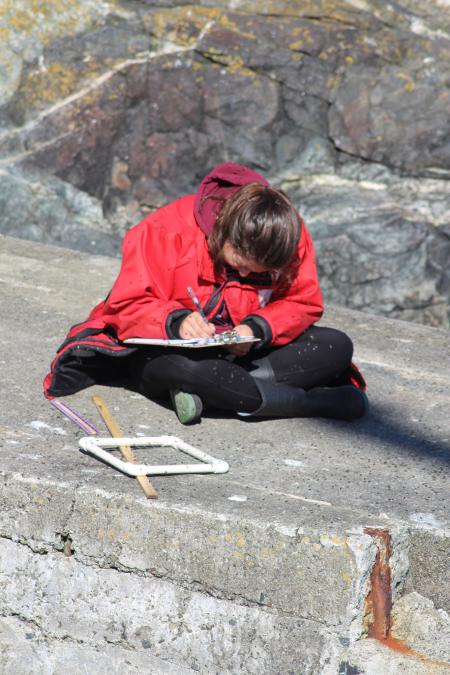
Ilana and flies
- Being charged by an elephant seal while collecting data
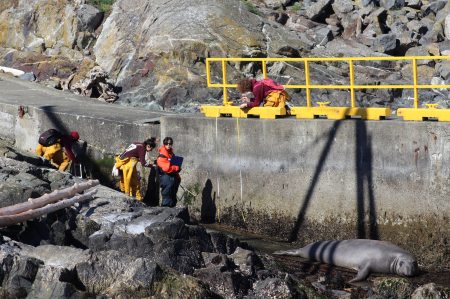
Ploypailin, Lauren, Xue Meng and Jill were all frightened from collecting data on the jetty by an elephant seal making its way to the water
All in all though a very successful morning. Thanks to Johannah, Malou and Steph for photos and invigilation! – see this link for more wonderful photos. Thanks to Chris, Reuben (from Ocean River Sports) and Guy for transport to and from Race Rocks. And thanks to Riley and the elephant seals for their hospitality – see this link for Riley’s post on the Race Rocks log about the Marine Science field exam.
Tags:field exam, Race Rocks, rocky intertidal, year 42
Posted in Events, Field trips, Fun Activities | Leave a Comment »
May 3, 2016
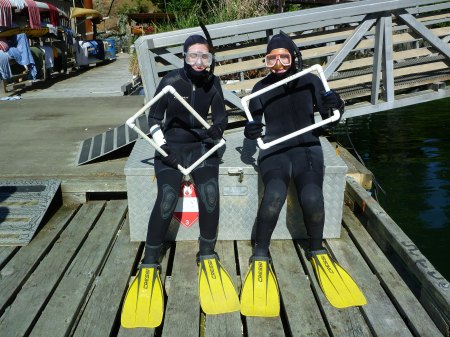
The challenge presented to first years for their last class of the year was to compare the biodiversity of two different habitats. Some students, like Kate and Jill above and Jacqueline and Aurora below, chose to snorkel to do the sampling.

Jacqueline in a ‘whole new world’!

Aurora with her sampling gear
Others sampled in the intertidal zone – see Ilana and Sho below.

Intertidal Ilana and snorkeling Jill

Sho recording diversity data
Ochuko and Axel compared the diversity of the two seawater tables that we have – one inside the floating lab and the other on the dock. (That’s Ochuko in the paw print onesie in the photo below.)

Lauren chose to investigate the substrates hanging off the dock.
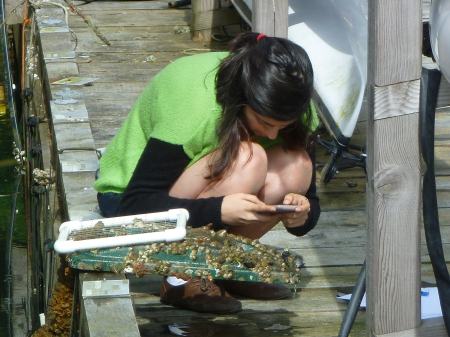
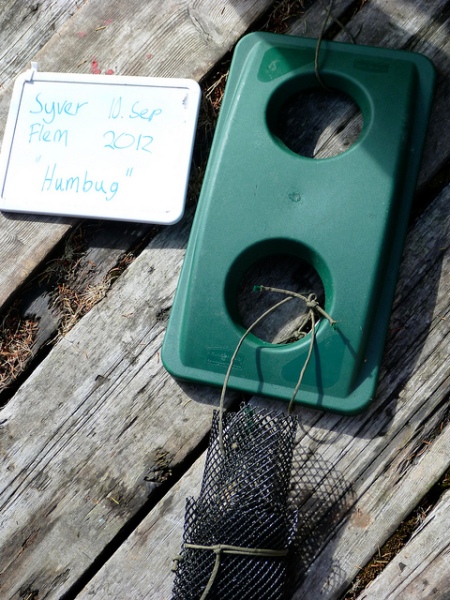
Above is a photo of the same substrate when Syver suspended it off the dock in September 2012, when the biodiversity was zero!
I’m not sure what kind of biodiversity Sho found under the ramp!? And that is Kate in the water in the photo above.
For more photos see Flickr album Biodiversity 2016.
Tags:biodiversity, Pedder Bay, snorkeling
Posted in Field trips, Fun Activities | 1 Comment »






















































































































